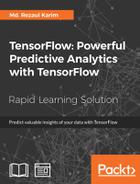TensorFlow is designed to make the predictive analytics through the machine and deep learning easy for everyone, but using it does require understanding some general principles and algorithms. Furthermore, the latest release of TensorFlow comes with lots of exciting features. Thus I also tried to cover them so that you can use them with ease. I have shown how to install TensorFlow on different platforms including Linux, Windows, and Mac OS. In summary, here is a brief recap of the key concepts of TensorFlow explained in this lesson:
- Graph: each TensorFlow computation can be represented as a set of dataflow graphs where each graph is built as a set of operation objects. There are three core graph data structures:
tf.Graphtf.Operationtf.Tensor
- Operation: A graph node takes tensors as input and also produces a tensor as output. A node can be represented by an operation object for performing units of computations such as addition, multiplication, division, subtraction or more complex operation.
- Tensor: Tensors are like high-dimensional array objects. In other words, they can be represented as edges of a dataflow graph but still they don't hold any value produced out of an operations.
- Session: A session object is an entity that encapsulates the environment in which operation objects are executed for running calculations on the dataflow graph. As a result, the tensors objects are evaluated inside the
run()oreval()invocation.
In a later section of the lesson, we introduced TensorBoard, which is a powerful tool for analyzing and debugging neural network models, the lesson ended with an example that shows how to implement a simple neuron model and how to analyze its learning phase with TensorBoard.
Predictive models often perform calculations during live transactions, for example, to evaluate the risk or opportunity of a given customer or transaction, in order to guide a decision. With advancements in computing speed, individual agent modeling systems have become capable of simulating human behavior or reactions to given stimuli or scenarios.
In the next lesson, we will cover linear models for regression, classification, and clustering and dimensionality reduction and will also give some insights about some performance measures.
